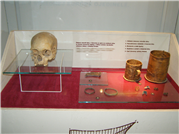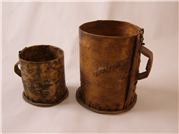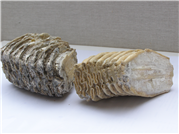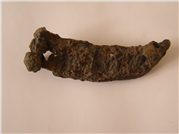The original location of the village is south-east, 3km away from Poprad. The village is situated in the southern part of the Popradská kotlina valley and the area is covered by predominantly palaeogenic sediments of the Central Carpathian Flysch. There are big yards of travertine which are bound to cross pits of the east-west direction as well as mineralized wells containing carbon oxide. The early yards originated in the Pleistocene and Holocene Ice Age. The majority of the yards originated later – at the time of the last interglacial ris / würm.
 The travertine hill Hrádok is the most famous (picture 1). From 1880s the travertine was mined there (picture 2). Many well-known paleobotanic and paleozolic fossils (picture 3) were found there. In 1926 the stone-cutter Koloman Koki (picture 4) found a part of skull (endocranium))
The travertine hill Hrádok is the most famous (picture 1). From 1880s the travertine was mined there (picture 2). Many well-known paleobotanic and paleozolic fossils (picture 3) were found there. In 1926 the stone-cutter Koloman Koki (picture 4) found a part of skull (endocranium)) filled with travertine. The anthropologist Dr. E. Vlček specified the origin of the skull as a part of cerebral cortex of the Neanderthal man (pictures 5, 6, 7). In 1955 – 1956 there was a detailed revisory research (Throughout the years of 1955-1950 the research works were lead by the anthropologists F. Prošek and E. Vlček). The results of all, archaeological, geological, and anthropological research showed many new and recognized findings. Among the findings, the prints of the spoke bone and the calf bone (picture 8) as well as working tools of the Neanderthal man (picture 9) were found. All these findings belong to the oldest findings on the territory of the Slovak Republic. On 17. – 23. June 1958 the International Committee in Prague and Gánovce proved the existence of the findings and the fact that the area of Gánovce is one of relevant findings of the Neanderthal man who lived there 105 000 years ago.
filled with travertine. The anthropologist Dr. E. Vlček specified the origin of the skull as a part of cerebral cortex of the Neanderthal man (pictures 5, 6, 7). In 1955 – 1956 there was a detailed revisory research (Throughout the years of 1955-1950 the research works were lead by the anthropologists F. Prošek and E. Vlček). The results of all, archaeological, geological, and anthropological research showed many new and recognized findings. Among the findings, the prints of the spoke bone and the calf bone (picture 8) as well as working tools of the Neanderthal man (picture 9) were found. All these findings belong to the oldest findings on the territory of the Slovak Republic. On 17. – 23. June 1958 the International Committee in Prague and Gánovce proved the existence of the findings and the fact that the area of Gánovce is one of relevant findings of the Neanderthal man who lived there 105 000 years ago.


The hill Hrádok was settled many times in later periods, predominantly in the Ottoman period. At that time the well with the wooden timbering originally with the depth of approx. 9m (picture 10) was built there. During the research in 1955 a lot of pottery, bronze objects, burnt human and animal bones, carbonized grain, bones of human hand with bracelets, then various earrings, buttons, golden tink, glass pearls, etc. were found there. A stylized female idol, stone phallus, rests of clay stove (pyraunos), rests of fingers, etc. were also found there. The finding of several birch-bark jars (picture 12) as well as birch-bark earrings was very surprising.



Not less surprising was the finding of an iron dagger handle (picture 13).  The blade of the dagger was not preserved as well as the dagger covering which may have been from bones. The handle of the digger (in the present considered to be a hook) belongs to the oldest findings of iron in Europe. The C14 analysis results showed that the wooden timbering of the well was built in the years of 1465 BC – 35 AD. The iron used to make such well was acquired by the metallurgical activity and not by using the meteorite iron.
The blade of the dagger was not preserved as well as the dagger covering which may have been from bones. The handle of the digger (in the present considered to be a hook) belongs to the oldest findings of iron in Europe. The C14 analysis results showed that the wooden timbering of the well was built in the years of 1465 BC – 35 AD. The iron used to make such well was acquired by the metallurgical activity and not by using the meteorite iron.
According to data from the pre-mining period, the area was surrounded by a big wall.
The youngest findings were originated from the Laten Period, the part of the Púchov culture and the Early Middle Ages – called the Slavonic Period. A small castle was there in the Middle Ages.
The village has also other settled areas. It is predominantly the area of Za stodolami settled mainly at the time of the Late Bronze Age. There is a grave in a clay jar from the period. .
The Podtatranské Museum in Poprad has presented the exhibition of findings from the village of Gánovce since 1969. The name of the unique exhibition is: „Gánovce – životné prostredie neandertálskeho človeka na Spiši“ (“Gánovce – Neanderthal Man environment in the Spiš region”).
Processed by: Podtatranské Museum, Poprad